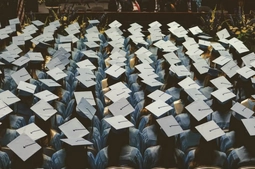What is Considered Plagiarism?
Plagiarism is a phenomenon that you can face in many spheres of life. It can be detected in literature, movies, songs, but most people become familiar with it in school while writing essays, research papers, and other pieces of academic works. So, academic plagiarism is what everyone is most familiar with.
Those students who were caught with a plagiarized work know themselves that they have done it, but for some reason hoped that their little lie would not be uncovered. Your academic paper will contain plagiarism if you do the following:
- Take someone’s work and present it as if it was you who wrote it. In this case, the possibility of plagiarism is 100%, especially if you downloaded the work from the Internet; but since the hard copy will show the same result, do not rely on this method either.
- Copy and paste some paragraphs, while writing the major part of the work yourself. In this case, your work will contain the percentage of plagiarism equal to the percentage of paragraphs that you have borrowed from other works in relation to the whole text. In other words, if around 20% of all paragraphs are not written by you, but copied and pasted from other sources, the plagiarism score will be something like 20%. Even if you take only 1 small paragraph of unoriginal text, the plagiarism program will still detect it and show the amount of unoriginal text, even though it is only a few percent.
- Copy and paste no more than one sentence per paragraph or less. This method will not work either. A plagiarism detection tool will still find the unoriginal text even if you take these sentences from different sources.
All these cases are considered academic plagiarism because you intentionally borrow pieces of text which do not belong to you, no matter whether it is one sentence or an entire paragraph. However, in some cases, a student who did not copy and paste any sentences from works of other authors may find out that his or her paper has plagiarized.
How is that possible? In such cases, you will be dealing with accidental plagiarism, which in fact is as bad as the ordinary one. Nevertheless, let’s try to understand its nature and how it may happen that your work contains it.
How to Avoid Accidental Plagiarism?
Accidental plagiarism can take place if you do one of the following things.
- Rewrite somebody’s text. Rewriting sentences or entire paragraphs may also be the cause of accidental plagiarism. It depends on your writing skills and a plagiarism detection tool. For instance, Turnitin is very and very picky, and it is very difficult to trick it with such a method. How does Turnitin detect paraphrasing? That’s a bit complicated question, and you will hardly find a certain answer, but one thing I can say for sure: if you want to beat Turnitin, a simple changing of the sentence structure, adding more words, or replacing adjectives will not be enough. Turnitin will easily detect it and even show the source that you used for rephrasing.
- Write somebody’s idea in your own words. Technically, it should not be detected as plagiarism unless you don’t do it too frequently. For example, a couple of rephrased sentences will not spoil your work. However, if you misuse this method, a plagiarism detection tool will underline some separate words or expressions as if they were plagiarized.
- Do not use proper in-text citation. It is not forbidden to use direct quotes in your work, but only when it is really necessary and until you do not put such quotes too often. Each direct quotation should be properly formatted, or it will be considered plagiarism. I’d also recommend you to avoid direct quotes and use them as little as possible to avoid possible undesired plagiarism.
These are the most common reasons which explain why you may have plagiarism in your work, although you didn’t copy and paste anything. Make sure that you do not do these three things which will surely lead to accidental plagiarism.
Plagiarizing Without Getting Caught
A dream of many students is to keep cheating without getting caught. It does not mean the learners want to steal somebody’s papers but rather use their ideas and concepts. Although it seems impossible, there are multiple tricks that will help you borrow some pieces of writing without plagiarizing it. Right, you will not just copy it so that the paper you come up with is unique and authentic.
If you need proof that it is true and that the methods I am talking about really work, just use any of the plagiarism detection programs. Just google “free plagiarism checker reddit” and you will immediately find a list of such tools which do not request money for usage. Test these methods and see for yourself that they can bring you benefits.
Wikipedia is your best friend
Frequently, when an educator assigns a new project complete with an exhaustive guide, one of the mandates is to utilize only credible sources, which often translates to a strict no-Wikipedia rule. Sometimes, the prohibition against using this site is even expressly stated. It's no secret why Wikipedia is seen as an unfitting source, yet ironically, it quite regularly offers accurate and concise information.
So this is how to not get caught plagiarizing. Wikipedia is a rapid-fire means to acquire a fundamental understanding of your topic in a mere quarter of an hour. Without its convenience, you could find yourself immersed in a half-day quest, poring over books, magazines, and periodical articles, only to end up with the same core knowledge. It is where the art of learning how to plagiarize successfully comes into play.
The goal here is not to plagiarize but to explore. Focus on the available information, process it, and come up with your own conclusions. Do you break the rules by taking some ideas from Wikipedia? Absolutely not, unless they are copied and pasted into your essay. Will the teacher be able to notice something? Well, avoid citing this source, using it just for deepening your understanding of the subject matter and learning more about the topic. The objective here is to harness the potency of Wikipedia as a time-saving research tool but do so judiciously and ethically to create unique work.
False citations
While Wikipedia's value is acknowledged, one might ask, "What if my assignment requires citations, and each page needs at least two? What source do I cite if I employ Wikipedia?" The solution is straightforward; you can cite any reputable source discussing the same topic.
This strategy is virtually foolproof, particularly when writing in APA style. In such instances, you only need to mention the author's name and the publication year when citing, making it much easier to blend in references without raising suspicion. Imagine the citation is nestled within the hundreds of pages of a sizable book. Who will verify it? The likelihood is quite minimal.
Even in citation formats that necessitate specifying a particular page, misleading citations often succeed. In 99% of instances, you won't be caught plagiarizing. Do you believe your educator possesses every book, article, and magazine you referenced at their fingertips? Will they scrutinize each of the 20-odd citations in your paper? Probably not, and here is where you have some leeway. You can leverage this minor trick to ensure you don't lose score points due to insufficient citations, thereby enhancing the credibility of your paper.
Although this method can be quite effective, your end goal is not to cheat or promote dishonesty but to avoid the risk of being caught plagiarising. If there are safer and more effective alternatives, prioritize them so that you remain honest even in the most challenging situations.
Smart paraphrasing
Will Turnitin detect plagiarism if I paraphrase a couple of sentences or even a paragraph? There's a strong chance that it will. However, what if you rephrase a more extensive text and avoid simple tactics such as using excess adjectives or swapping words with their synonyms? The truth is that paraphrasing can be an effective strategy when executed correctly.
In fact, paraphrasing is one of the most beneficial and safe ways to use someone’s ideas in your papers without any possible outcomes. The only condition here is that you know how to do it right. Browsing the web you will come across tons of strategies drawing you closer to the desired results. Here are some of them that may become game changers.
- Add some adverbs and adjectives into the text. This is the simplest way to trick the plagiarism-detecting apps and still take advantage of interesting data sources.
- Change the word order. This is a smart way to paraphrase the text, as it will not affect the content but will surely prevent you from potential risks.
- Shorten sentences. Make sure you do not copy the exact words, but add some pauses and other little items to the original sentences. This way, you will change their structure, which will make them undetectable for the plagiarism checker.
- Add your opinion. Using extra sources of information is not about the desire to save time and reduce the amount of work you need to do but rather an attempt to come up with a more appealing and meaningful paper. Therefore, inserting a few sentences with your attitude towards discussed matters may help you achieve both goals. It will make plagiarism detection impossible and also strengthen the reasoning in your essay.
So this is how to not get caught plagiarizing an essay. Your paraphrasing efforts should be a thoughtful translation of the core ideas into your voice, not merely a cosmetic text restructuring. When done well, paraphrasing allows you to incorporate essential elements of other works into your essay while maintaining your originality and integrity. Remember, smart paraphrasing isn't about pulling the wool over anyone's eyes but understanding and presenting information freshly.
Swapping letters
I do not consider this method a reliable one and trustworthy because once a teacher understands the trick, there will not be a chance for you to say that you did it accidentally or that it was just a mistake. However, if you want to know how to copy and paste without plagiarizing software like quetext plagiarism checker, then this method can help you. There are some letters in other languages which are the same as in English, for example, you can find “a,” “i,” or “e” in a Cyrillic alphabet.
So, if you change the English “a” with the Cyrillic “a”, the word will still look the same, but for a plagiarism tool, it will be a non-existing word and hence, original. You can copy and paste an entire paragraph, change letters in some words, and get a 100% unique text. Yes, that’s cheating and obviously plagiarism, but if you have no other choice, this will work. I’d recommend using this approach as a last resort though.
Rearranger tools
Surfing the Internet, looking for more ways to trick plagiarism detection tools, I stumbled upon the how to plagiarize without getting caught reddit post. There, I found an idea that seemed a bit controversial, but which can work too. People talked about some tools called a word rearranger. Technically, it is the same as when you substitute the words with synonyms or extend a sentence by adding more adjectives to reduce plagiarism.
So, first, I didn’t notice any value in this piece of advice, but then I figured out that you can use this tool several times, and it will change the words again and again until you get a custom text. Just copy and paste a text and click the button a few times to receive a new text. I am not sure that it will vanquish academic plagiarism in 100% of cases, but at least it will significantly reduce it, and the rest you can change by yourself, saving a lot of time on writing or paraphrasing.
How to Not Plagiarize
As you can see, there are some ways which you can use to add some free non-plagiarized content in your work. However, none of these methods can help you to unplagiarize the whole paper, and there is still a chance that you can be caught on using somebody’s ideas without proper citation. But what about some really reliable methods which, on the one hand, allow you not to write a paper by yourself, and on the other hand, get a 100% unique paper? Is it possible to find a way like this?
Actually, yes, this method does exist. There are companies that provide academic writing services to students. For example, you need to write a 4-page essay. You visit a site of one of such companies, place an order, and wait until they do all the work for you. Your assignment will be completed according to the deadline you set and the instructions you provide. The companies guarantee 100% unique papers written from scratch according to the topic and instructions you provide.
On our site, you can find a reliable essay writing service. Not every service on the market meets high standards, which is why we created a list of top-rated essay writing companies with a solid reputation. These services are considered the most trustworthy and reliable according to our own investigation and the opinion of many customers who have been using these services many times. If you decide to use one of these companies from our top list, you will get a 100% unique paper, and you will not need to ponder on how to write a plagiarism-free paper anymore.
Confidentiality of clients is one of their supreme goals. No one will ever know that you are ordering from essay writing services. Your personal information will be kept secret, and there is not a chance for your professor to figure out that you have ever used the assistance of companies like this.
It's crucial to know how to present ideas originally and avoid accusations of plagiarism. Here are four more strategies to help students maintain the integrity of their work:
- Thorough understanding: Before paraphrasing or summarizing, ensure you completely understand the material. Grasping the concept allows you to explain it in your unique voice without mimicking the original text.
- Quote sparingly: Quotations can serve as powerful tools when used judiciously. However, overreliance on them can lead to plagiarism allegations. Use them sparingly and always properly attribute the source.
- Cite everything: If you include someone else's idea, thought, or data in your paper, cite it, even if you've reworded it. Unintentional plagiarism can happen when you fail to credit the source properly.
- Use plagiarism checkers: Take advantage of the many online plagiarism-checking tools available to help ensure your paper is original. It allows you to rectify any issues before submitting your work.
In the context of how to plagiarize, it's worth noting that the goal is not to learn how to cheat the system but to understand the practices that might be construed as plagiarism. This way, students can take proactive measures to prevent it and promote academic honesty.
As demonstrated, several techniques exist to freely incorporate non-plagiarized content into your work. However, no method is foolproof for completely avoiding plagiarism in a paper, and there's always a lingering possibility of being flagged for borrowing someone else's ideas without proper citation. But are there trustworthy methods that ensure originality while sparing you from writing the entire paper? Is such a path feasible?
Indeed, such an approach exists. Various companies offer academic writing services to students. Suppose you need a four-page essay. In that case, you can visit the website of one such organization, submit an order, and wait for them to handle the task on your behalf. Your assignment will be executed as per your set deadline and the guidelines you provide. These companies assure 100% unique papers crafted from scratch in line with your topic and instructions.
Hence, these services offer a viable solution if you're seeking a blend of convenience and originality. However, remember the aim should always be to develop your knowledge and skills, rather than just outsourcing all your work. Use such services wisely and ethically.
FAQs
Ensuring content uniqueness is crucial because it helps you stand out from the competition, captivate your audience, and avoid issues related to plagiarism or duplicate content penalties.
Writers can employ strategies such as thorough research, using their unique voice and perspective, incorporating personal experiences, and referencing diverse sources to craft original content.
Content creators can maintain consistency in uniqueness by establishing a distinct brand voice, adhering to a content style guide, regularly updating content, and seeking feedback from their audience to refine their approach.




